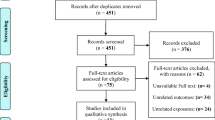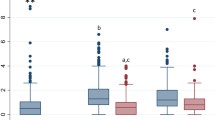Abstract
The influence of application of skin-lightening creams and dental amalgam fillings on the urinary mercury (Hg) level was evaluated in 225 females (ages 17 to 58 years) living in Riyadh, capital of Saudi Arabia. The arithmetic mean of the urinary Hg level was 6.96 ± 20.43 μg l, in the range 0 to 204.8 μg l. The mean urinary Hg level adjusted by creatinine (Cr) was 11.22 ± 37.23 μg g Cr, in the range 0 to 459.37 μg g. No significant difference in urinary Hg was noted between the females regarding the use of skin-lightening creams. On the other hand, results showed that urinary Hg concentration was influenced by the use and number of dental amalgam fillings. No women were identified with symptoms or signs that could be attributed to Hg intoxication. Urine analyses for creatinine, urea, uric acid, phosphorus, magnesium, glucose and calcium showed significant correlation with urinary Hg. This suggests that chronic exposure to Hg may be associated with a deterioration of renal function.
Similar content being viewed by others
References
Abraham JE, Svare CW, Frank CW. 1984 The effect of dental amalgam restorations on blood mercury levels. J Dent Res 63, 71–73.
Al-Saleh I, Al-Doush. 1997.
Aronsson AM, Lind B, Nylander M, Nordberg M. 1989 Dental amalgam and mercury. Biology of Metals 2(1), 25–30.
ATSDR, Agency for Toxic Substances and Disease Registry. 1992 Mercury toxicity. Am Family Physiain 46(6), 1731–1741.
Barr RD, Woodger BM, Rees PH. 1973 Levels of mercury in urine correlated with the use of skin lightening creams. Am J Clin Pathol 59, 36–40.
Barregard L, Sallsten G, Jarvholm B. 1995 People with high mercury uptake from their own dental amalgam fillings. Occup Environ Med 52(2), 124–128.
Battistone GC, Hefferen J, Miller RA, Cutright DE. 1976 Mercury: its relation to the dentist's health and dental practice characteristics. J Am Dent Assoc 92, 1182–1188.
Begerow J, Zander D, Freier I, Dunemann L. 1994 Longterm mercury excretion in urine after removal of amalgam fillings. Int Arch Occup Environ Health 66(3), 209–212.
Berglund A. 1990 Estimation by a 24 hour study of the daily dose of intraoral mercury vapor inhaled after release from dental amalgam. J Dent Res 69, 1646–1651.
Berlin M. 1979 Mercury. In: Friberg L, Nordberg GF, Vouk VL, eds. Handbook on the Toxicology of Metals. Amsterdam: Elsevier/ North-Holland; 503–530.
Bjorkman L, Lind B. 1992 Factors influencing mercury evaporation rate from dental amalgam fillings. Scand J Dent Res 100, 354–360.
Boadi WY, Urbach J, Brandes JM, Yannai S. 1992In vitroexposure to mercury and cadmium alters term human placental membrane fluidity. Toxicol Appl Pharmacol 116, 17–23.
Bourgeois M, Dooms-Goossens A, Knockaert D, et al. 1986 Mercury intoxication after topical application of a metallic mercury ointment. Dermatologica 172, 48–51.
Craig RG. 1985Restorative Dental Materials. St. Louis: CV Mosby Co.; 221.
Diamond GL. 1988 Biological monitoring of urine for exposure to toxic metals. In: Clarkson TW, Friberg L, Nordberg GF, Sager P, eds. Biological Monitoring of Metals. New York, London: Plenum Press; 515–529.
Enwonwu CO. 1987 Potential health hazard of the use of mercury in dentistry. Environ Res 42, 257–274.
Friberg L, Skog E, Wahlberg JE. 1961 Resorption of mercuric chloride and methyl mercury dicyandiamide in guinea-pigs through normal skin and through skin pretreated with acetone, alkylarylsulphonate and soap. Acta Dermatovenereol 41, 40–52.
Fung YK, Molvar MP. 1992 Toxicity of mercury from dental environment and from amalgam restorations. Clin Toxicol 30(1), 49–61.
Gale TF. 1981 The embryotoxic response produced by inorganic mercury in different strains of hamsters. Environ Res 24, 152–161.
Gale TF, Ferm V. 1971 Embryopathic effects of mercuric salts. Life Science 10, 1341–1347.
Gale TF, Hanlon DP. 1976 The permeability of the Syrian hamster placenta to mercury. Enivron Res 12, 26–31.
Giunta F, Dilandro D, Chiarmda M. 1983 Severe acute poisoning from the ingestion of a permanent wave solution of mercuric chloride. Human Toxical 2, 243–246.
Gough JE. 1978 Amalgam material as an occupational hazard. Dent Surv 54, 26–35.
Herrstrom P, Schutz A, Raihle G, et al. 1995 Dental amalgam, low exposure to mercury, and urinary proteins in young Swedish men. Arch Environ Health 50(2), 103–107.
Holt D, Webb M. 1986 The toxicity and teratogenicity of mercury in the pregnant rat. Arch Toxicol 58, 243–248.
Jeddeloh RJ, Lake KD, Brown DC. 1985 Ammoniated mercury membranous nephropathy. Minnesota Med 68, 591–592.
Joselow MM, Goldwater LJ. 1967 Absorption and excretion of mercury in man. XII. Relationship between urinary mercury and proteinuria. Arch Environ Health 15, 155.
Kaplan A, Szabo LL, Opheim KE. 1988Clinical Chemistry: Interpretation and Techniques. 3rd edn. Philadelphia, USA: Lea and Febiger; 112–144.
Kavlock RJ, Gray LE Jr. 1983a Morphometric, biochemical and physiological assessment of perinatally induced renal dysfunction. J Toxicol Environ Health 11, 679–690.
Kavlock RJ, Gray LE Jr. 1983b Postnatal evaluation of morphological and functional effects of prenatal exposure to nitrofen in the Long-Evans rat. J Toxicol Environ Health 11, 1–13.
Kibuhamusohe JW, Davies DR, Hutt MSR. 1974 Membranous nephropathy due to skin lightening cream. Br Med J 2, 646–647.
Kuhnert PM, Kuhnert BR, Ehrard P. 1981 Comparison of mercury levels in maternal blood, fetal cord blood and placental tissues. Am J Obst Gynecol 139, 209–213.
Lauwerys R, Bonnier CH, Evrard PH, Gennart PH, Bernard A. 1987 Prenatal and early postnatal intoxication by inorganic mercury resulting from the maternal use of mercury containing soap. Human Toxicol 6, 253–256.
Lindstedt G. 1970 A rapid method for the determination of mercury in urine. Analyst 95, 264–270.
Lorscheider FL, Vimy MJ, Summers AO. 1995 Mercury exposure from silver tooth fillings: emerging evidence questions a traditional dental paradigm. FASEB J 9(7), 504–508.
Lyons TJ, Christu CN, Larsen FS. 1975 Ammoniated mercury ointment and the nephrotic syndrome. Minnesota Med, 58, 383–384.
Mackert JR Jr. 1987 Factors affecting estimation of dental amalgam mercury exposure from measurements of mercury vapor levels in intraoral and expired air. J Dent Res 66, 1775–1780.
Marzulli FN, Brown WC. 1972 Potential systemic hazards of topically applied mercurials. J Soc Cosmet Chem 23, 875–886.
Naleway C, Sakagguchi R, Mitchell E, et al. 1985 Urinary mercury levels in US dentists, 1975-1983: review of health assessment program. J Am Dent Assoc 111(1), 37–42.
Neubert D, Stahlmann R, Chahoud I, Bochert G. 1985 Some aspects of prenatal toxicology. TIPS(suppl.), 21–26.
Oliveira D, Foster G, Saville J, Syme PD, Taylor A. 1987 Membranous nephropathy caused by mercurycontaining skin-lightening cream. Postgrad Med J 63, 303–304.
Patterson N. 1984 The longevity of restorations. Br Dent J 157, 23–25.
Rosenman KD, Valciukas JA, Glickman L, et al. 1986 Sensitive indicators of inorganic mercury toxicity. Arch Environ Health 41, 208–215.
Rowland AS, Baird DD, Weinberg CR, et al. 1994 The effect of occupational exposure to mercury vapour on the fertility of female dental assistants. Occup Environ Med 51(1), 28–34.
Schulte A, Stoll R, Wittich M, Pieper K, Stachniss V. 1994 Mercury concentrations in the urine of children with and without amalgam fillings. Schweiz Monatsschr Zahnmed 104(11), 1336–1340.
Siew C, Chang SB, Gruninger S. 1987 Organomercury: additional threat?Calif Dent Assoc J 15, 18–21.
Silverberg DS, McCall JT, Hunt JC. 1967 Nephrotic syndrome with the use of ammoniated mercury. Arch Int Med 120, 581–586.
Skog E, Wahlberg JE. 1964 A comparative investigation of the precutaneous absorption of metal compounds in the guinea-pig by means of the radioactive isotopes:31Cr, 36Co, 63Zn, 110mCd, 203Hg. J Invest Dermatol 43, 187–192.
Snapp KP, Boyer DB, Peterson LC, Svare CW. 1989 The contribution of dental amalgam to mercury in blood. J Dent Res 68, 780–785.
Statgraphics software: Statistical graphics system by statistical graphics corporation, A PLUS *WARE software product, STSC, INC., 1992.
Suzuki T, Hongo T, Abe T, Matsuo N, Inoue N. 1993 Urinary mercury levels in Japanese school children: influence of dental amalgam fillings and fish eating habits. Sci Total Environ 136(3), 213–227.
Tubbs RR, Gephardt GN, McMahon JT, et al. 1982 Membranous nephropathy associated with industrial mercury exposure. Am J Clin Pathol 77, 409–413.
Turner MD, Marsh DO, Smith JC, et al. 1980 Methylmercury in populations eating large quantities of marine fish. Arch Environ Health 35(6), 367–379.
Vimy MJ, Lorscheider FL. 1985a Serial measurements of intra-oral air mercury: estimation of daily dose from dental amalgam. J Dent Res 64, 1072–1075.
Vimy MJ, Lorscheider FL. 1985b Intra-oral air mercury released from dental amalgam. J Dent Res 64, 1069–1071.
Wahlberg JE. 1965 "Disappearance measurements", a method for studying percutaneous absorption of isotope-labeled compounds emitting gamma-rays. Acta Dermat-Venereol 45, 397–414.
WHO, World Health Organization 1980. Recommended health-based limits in occupational exposure to heavy metals. Report of a WHO Study Group, Geneva, WHO Technical Report Series 647, p. 116.
WHO, World Health Organization 1991. Environmental Health Criteria 118: Inorganic mercury. WHO, Geneva.
Author information
Authors and Affiliations
Rights and permissions
About this article
Cite this article
Al-Saleh, I., Shinwari, N. Urinary mercury levels in females: Influence of skin-lightening creams and dental amalgam fillings. Biometals 10, 315–323 (1997). https://doi.org/10.1023/A:1018380501673
Issue Date:
DOI: https://doi.org/10.1023/A:1018380501673




